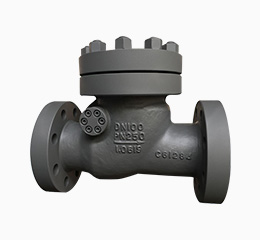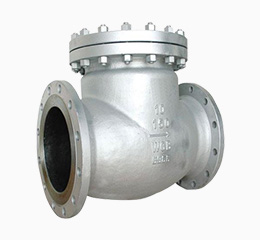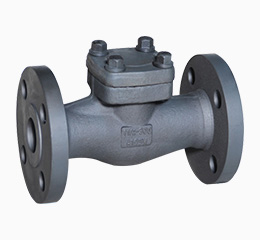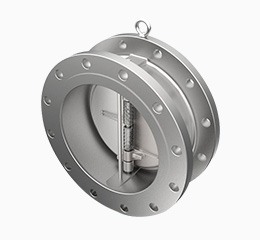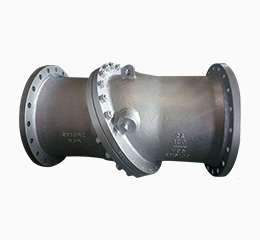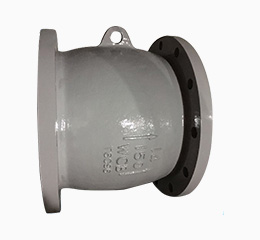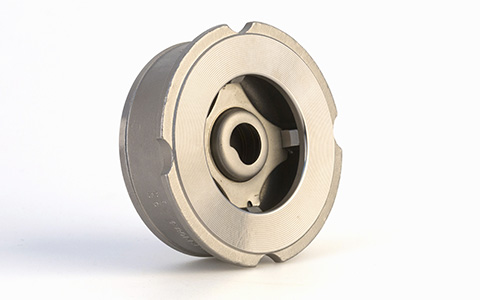Check Valve Manufacturer
Home » Check Valve
Check Valve
XHVAL is a check valve manufacturer that offers six types of check valves. Our valve factory in China employs two kinds of materials for its valves: cast steel and forged steel. These are suitable for high and low-pressure applications. XHVAL is also a supplier of dual plate wafer check valve, tilting plate check valve, and non-slam check valve.
REQUEST A QUOTE FOR MORE DETAILS
All You Need To Know About Check Valves
Check valves are unidirectional valves prevent backflow of media. Other terms used by check valve manufacturers for these valves are non-return valve or one-way check valve. Check valves work automatically so there is no need for a wheel or actuator.
Consider a check valve when there is imminent damage due to backflow or to prevent contamination. That being said, there should be the right orientation of the lone inlet and outlet to ensure that the check valves are functioning properly.
This article discusses popular topics on check valves, including their applications, mechanisms, buying considerations, as well as the different classifications of check valves.
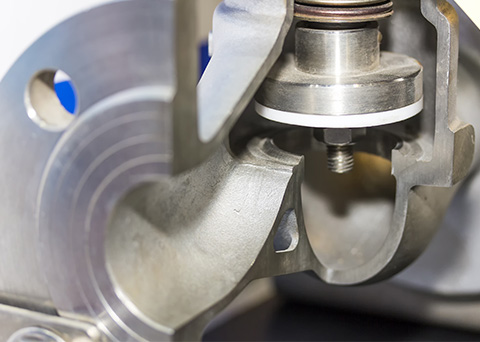
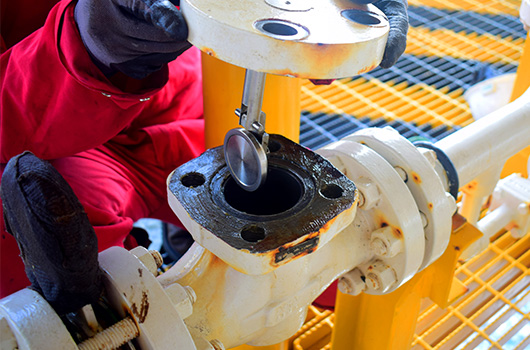
What Are Check Valves Used For?
Since check valves are non-return valves, common applications are tied to backflow issues.
- Sewage lines where upstream contamination is an issue
- Reverse osmosis filters where water should only move in one direction
- Applications that need vacuum sealing
- Applications that reduce equipment damage due to backflow
How Do Check Valves Work?
The check valve mechanism works by employing pressure differential. In layman’s terms, check valves use pressure to open or close the valve. For instance, the inlet should have higher pressure when the valve needs to open. This is called the cracking pressure.
On the other hand, the valve closes when the outlet side has more pressure or the inlet side does not have enough pressure to open the valve.
Knowing the pressure differential is also vital in computing the right pressure for the pipes and valve. Know more about how check valves work in this video:
Opening of Check Valve
Cracking pressure is the minimum required pressure for the valve to open. The valve size and design affect the cracking pressure. While cracking pressure is the minimum required pressure for valve opening on the inlet side, pressure differential is the pressure difference between the two openings. Cracking pressure is important because by knowing the minimum upstream pressure means better life service of the valve. It also means that the pressure is enough for a certain application.
Closing of Check Valve
Closing of the valves can be one of two reasons. First, the outlet pressure is higher than the inlet pressure. Second, the media flow is trying to move from the outlet back to the inlet. Depending on the design, be it a ball, gate or diaphragm, the pressure would push against it, thereby, sealing the valve.
There is much emphasis on the installation because an inline check valve works only in one direction. Installation is quite practical since there is a check valve symbol, an arrow, that shows the flow direction. Improper installation would not make the media flow through the valve and this could lead to pressure build-up.
Why Choose Check Valves?
Simple design
No need for human intervention
Effectively prevents backflow
Can be used as a backup system
Considerations When Buying Check Valves
The ideal check valve is the one that has a disc that can resist backflow pressure and prevent flow leakage. However, most choose check valves because of the size of the pipes as well as the largest Cv possible.
Many fail to understand the importance of disc performance since it is always used in the flow of the media. The material used for the disc is a priority. If there isn’t enough flow in the valve, the disc tends to bear most of the damage.
#1 Material Compatibility
Material has a great impact on the service life of XHVAL check valves. The material should be compatible with the type of fluid. Pressure from the fluid plays an important role in check valves. Therefore, the material should be strong enough to resist fluid pressure.
Additionally, corrosion is also dependent on temperature. That being said, the material should also resist high pressure and temperature if the conditions require it.
#2 Flow Rate
The flow rate determines the pressure needed by the check valve to open or close it.
#3 Operating Conditions
Factors such as the external and internal pressures, valve orientation, schedules of repair and maintenance affect the disk and the valve itself.
#4 Pipe Size
The right fit to the pipe size is important since threaded check valves are important. With this in mind, knowing how this valve type should be installed is as important.
#5 Maximum Pressure & Cracking Requirement
These types of valves are dependent on the cracking pressure to open it. The maximum pressure determines the amount of pressure the valve is able to handle at maximum.
#6 Installation Requirement
Horizontal orientation is the most common one, but there are also vertically mounted valves in the market. Without the proper orientation during the installment, the valve would not work at all. Many check valve manufacturers include a valve symbol to make it easier to know the orientation during installation.
Check Valve Types By Design
There are several types of check valves. Most of these work the same, that is, using the cracking pressure to open the valve and the backpressure to close it. Only the design differs. Each has its advantages and disadvantages too.
Ball Check Valve
The ball check valve, as its name connotes, uses a ball-like structure, can either be free-floating or spring-loaded. This ball has a conical seat that guides it when there is reverse flow.
To open the valve, the pressure must be more than the cracking pressure, dislodging the ball in the seat. This allows the flow of the media into the valve. The valve closes when the pressure drops. The spring aids the ball during the closing.
Stop Check Valve
A stop check valve is similar to the y-check or lift check valve; the only difference is that there is an actuator or a manual overdrive that can manipulate the media flow. This type of valve, then, works in two ways: a check valve and a shut on/off valve. One can see this type in power plants and steam generators or safety systems.
Diaphragm Check Valve
The diaphragm check valve uses a rubber diaphragm that is self-centering and floating. It is normally open so no cracking pressure to really open the valve. As the pressure increases, the diaphragm also adjusts to the pressure of the incoming flow.
However, the backflow pressure supports the closing of the valve. As this type of check valve is normally open, this is most suitable for low-pressure applications.
Duckbill Valve
The end of this valve looks like the beak of the duck, hence the name. The duckbill-like side of this valve is made of soft rubber that inflates when there is more pressure on the inlet part. However, the duckbill exit returns to the flat shape when there is no pressure, closing the valve.
Foot Valve
Installation of this strainer-check valve combination is at the end of the piping system. Additionally, the strainer at the inlet side prevents dirt from entering the valve. Often found at the end of a pump suction or fuel tank, it prevents backflow.
Spring Loaded Check Valve
There are two kinds of valves that employ spring when opening or closing the valve.
Spring Loaded In-Line Check Valve
The spring loaded in-line check valve has one of the simplest designs for check valves. This is also known as nozzle check valves or silent check valves. If you want to know more about brass inline check valves, check the video above.
There is a spring that aids the quick closing of the valve. Media flows into the valve when the pressure is higher than the cracking pressure, which then pushes the disk open, allowing the media to pass through.
If the back pressure or when the initial pressure has died down, the disc closes with the aid of the spring. One disadvantage of this type of check valve is that full removal of the valve is required for maintenance or repair.
Spring Loaded Y-Check Valve
The spring loaded Y-check valve is the other spring check valve type. Unlike the in-line variety where the spring and disc are in the same with the rest of the valve parts, the loaded y-check valve is positioned in an angle, creating a Y-shaped valve.
This makes the cleaning and maintenance of the valve easier because there is no need to detach it from the valve body. The only disadvantage is that the valve is bulkier than the in-line variety.
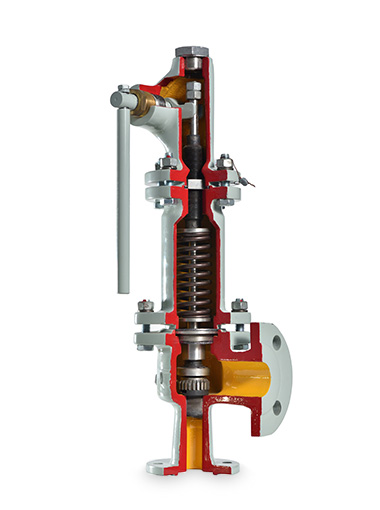
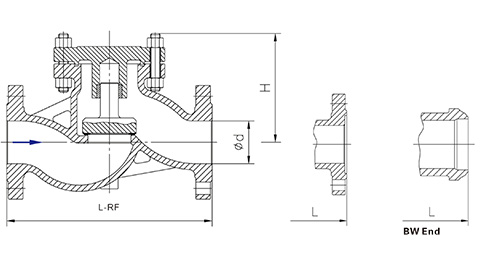
Lift Check Valve
Lift check valves use a disc that goes up or down as it opens or closes. The valve closes with the aid of spring or simply by gravity as it pressure from the outlet pushes the disc downwards to close it.
When there is no spring present, the mounting orientation must be important as this will guide the disc to completely shut off with the aid of gravity. While there are inline varieties of this type, the most common design pushes the media to a quarter turn.
Swing Check Valve
Otherwise known as the tilting disc check valve, it has a disc that is swinging on a hinge that acts as the stopper when there is enough pressure to withstand the cracking pressure.
The swinging disc closes when the backflow pressure is greater or the inlet pressure is lower. This type of check valve could have a spring to aid the closing or without out. In case of the latter, gravity works to close the disc.
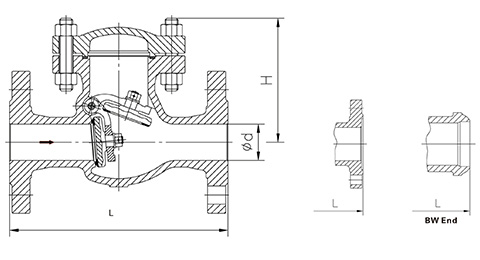
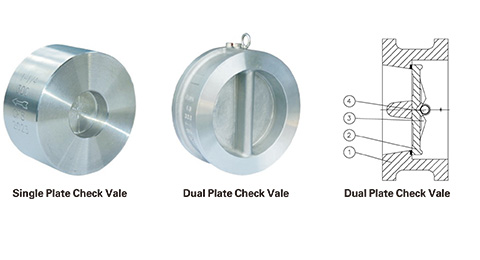
Butterfly Check Valve
Also known as the wafer check valve, this check valve variety has a wafer or butterfly disk attached on a hinge and supported by a spring.
When the inlet pressure is more than the cracking pressure, the two sides of the disc opens to allow media flow to the valve. Furthermore, when the inlet pressure wanes or the backflow pressure increases, with the aid of the spring between the two sides, the valve closes.
Check Valve Types By Material
Check valves also come in different materials. Each of these function differently. Each also has its advantages and disadvantages. The different materials allow suitable fluids to pass through the pipes and valves without decreasing its system life.
Stainless Steel Check Valve
While not a cost-effective material, stainless steel can withstand heat and corrosion.
Plug Disk Check Valve
Water management applications use PVC valves. Compared with polypropylene (PP), this can only tolerate temperatures up to 60°C. Additionally, this is resistant to corrosive media but not to aromatic and chlorinated hydrocarbons.
PP Check Valve
Called polypropylene, use this material with inorganic acids. However, do not use it with concentrated acid with high temperature. Water and liquid food applications are the common uses for this valve.
Brass Check Valve
This material is best suited for air, water, oil, and fuel and most often used with low-pressure applications. Avoid using this with seawater, purified water or chlorinated water. Compared to stainless steel, they don’t do well with heat and corrosion.
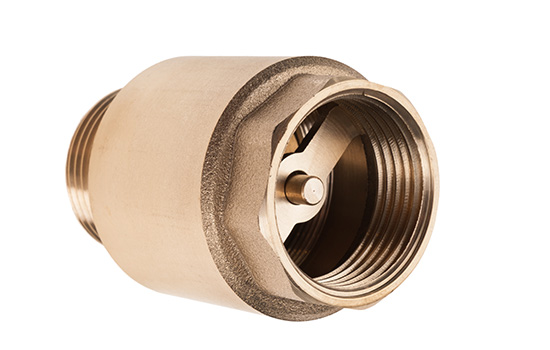
Request A free quote
Or contact us to see our certificates
We'd like to work with you
- +86 577 5768 9696
- [email protected]

